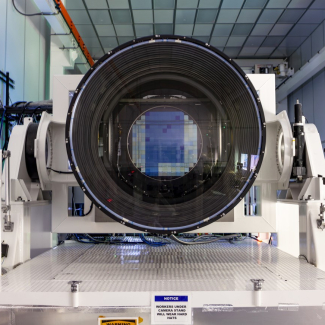
Surprising dunes on comet Chury
Surprising images from the Rosetta spacecraft show the presence of dune-like patterns on the surface of comet Chury. Researchers at the Laboratoire de Physique et Mécanique des Milieux Hétérogènes (CNRS/ESPCI Paris/UPMC/Université Paris Diderot) studied the available images and modeled the outgassing of vapor to try to explain the phenomenon. They show that the strong pressure difference between the sunlit side of the comet and that in shadow generates winds able to transport grains and form dunes. Their work is published on 21 February 2017 in the journal PNAS.
The formation of sedimentary dunes requires the presence of grains and of winds that are strong enough to transport them along the ground. However, comets do not have a dense, permanent atmosphere as on Earth. Nonetheless, the OSIRIS camera on board the Rosetta spacecraft showed the presence of dune-like forms approximately ten meters apart on 67P/Churyumov-Gerasimenko. They are found on the lobes of the comet as well as on the neck that connects them. Comparison of two images of the same spot taken 16 months apart provides evidence that the dunes moved and are therefore active.
Faced with this unexpected finding, the researchers show that there is in fact a wind blowing along the comet's surface. It is caused by the pressure difference between the sunlit side, where the surface ice can sublimate due to the energy provided by the sunlight, and the night side. This transient atmosphere is still extremely tenuous, with a maximum pressure at perihelion, when the comet is closest to the Sun, 100 000 times lower than on Earth. However, gravity on the comet is also very weak, and an analysis of the forces exerted on the grains at the comet's surface shows that these thermal winds can transport centimeter-scale grains, whose presence has been confirmed by images of the ground. The conditions required to allow the formation of dunes, namely winds able to transport the grains along the ground, are thus met on Chury's surface.
This work represents a step forward in understanding the various processes at work on cometary surfaces. It also shows that the Rosetta mission still has many surprises and discoveries in store.

Left, an image of comet Chury showing outgassing of water vapor, which entrains dust (© ESA/Rosetta/NAVCAM). Right, the neck region, between the comet's two lobes. Various types of relief can be seen, including the dunes, at bottom left (circled in red), in the sandy region.
Giant ripples on comet 67P/ChuryumovGerasimenko sculpted by sunset thermal wind. Pan Jia, Bruno Andreotti and Philippe Claudin. PNAS, 21 February 2017. View web site


